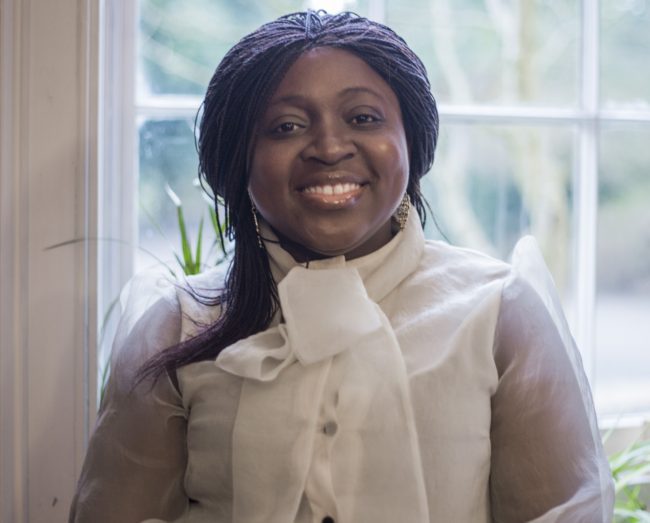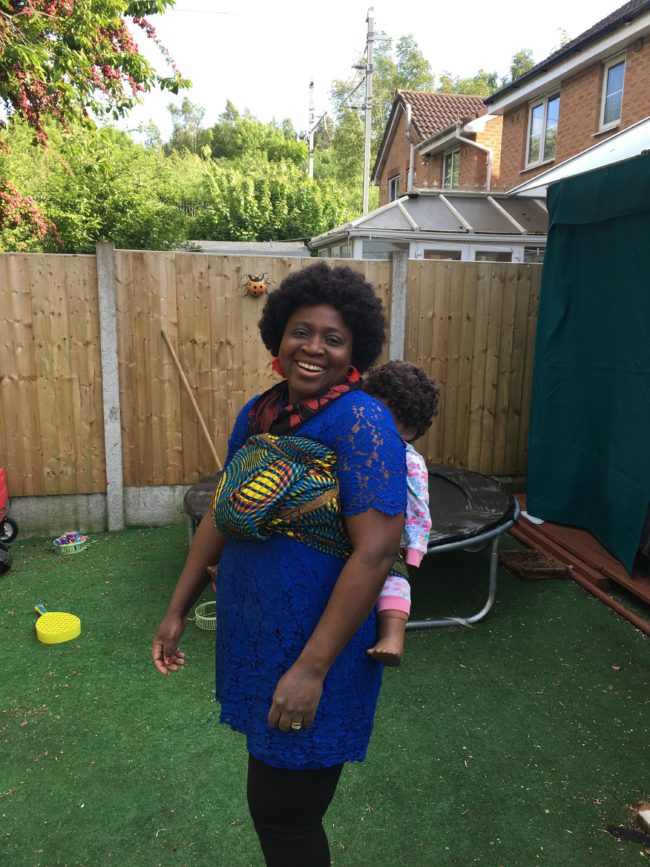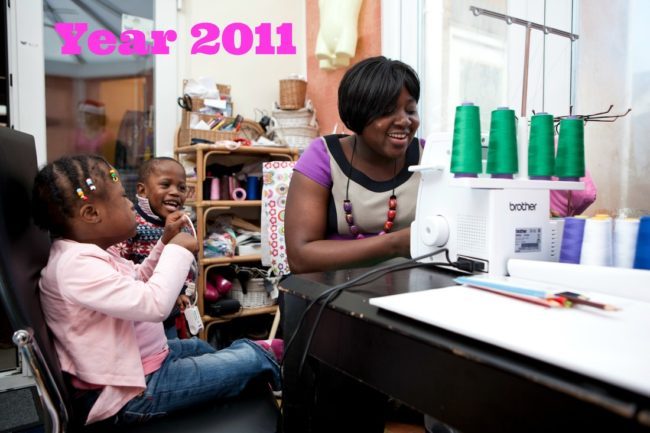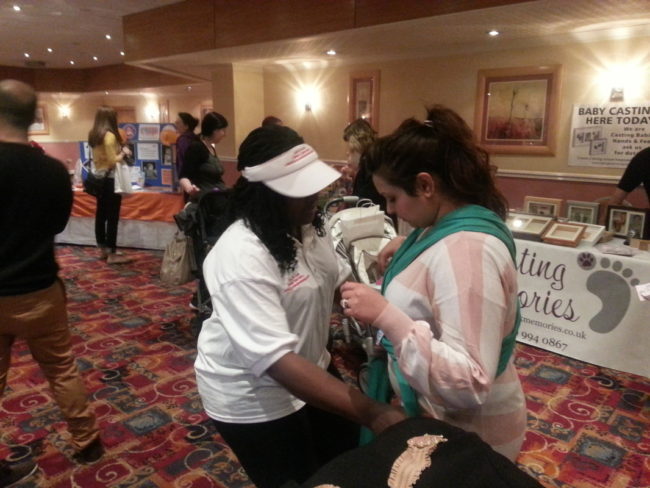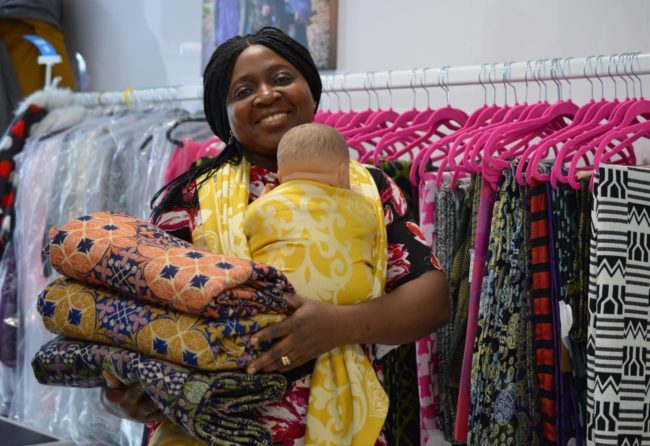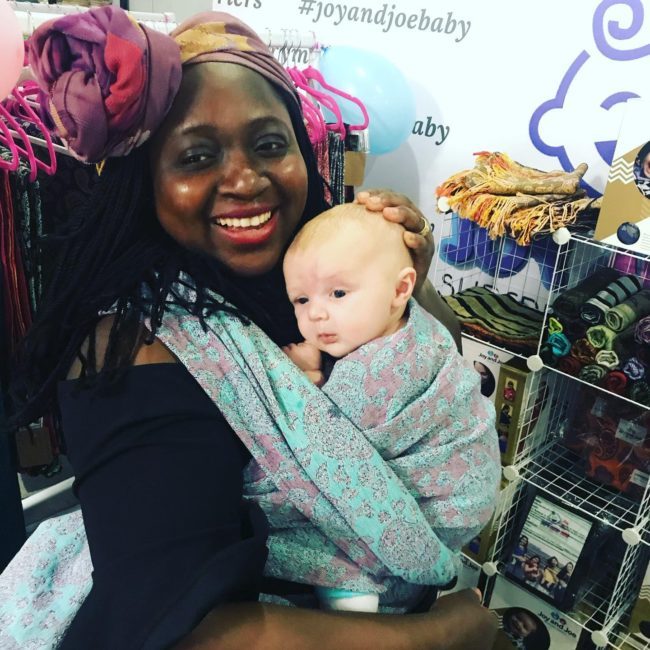An Interview With Bisi – Black Owned Babywearing Business Owner of Joy and Joe Baby
Welcome to Day 3 of Black Babywearing Week UK. I hope you are enjoying the content we have been creating across our social media channels thus far? As promised, my next article in celebration of this week I bring you An Interview With Bisi, Black Owned Babywearing Business Owner of Joy and Joe Baby…
What inspired you to babywear your children?
Survival and Necessity! I needed to care for my children who both have special needs. With reflux and mobility and feeding problems, my daughter had to be held upright at all times, I had to babywear in order to have my hands free to be able to do simple things like read a book or even eat a meal.
Were you traditionally worn as child?
Yes, my late mother shared fond stories of how people often teased her in our village whenever she carried me on her back.
She is fair skinned and I’m dark skinned (like my dad) so she said that people often jokingly told her to return the baby to the rightful owner because we didn’t look alike at first glance!
I was traditionally worn most of the time, growing up in Africa because this was our normal way of life. My mum often laughed whenever she recounts an incidence that happened in the bank.
My mum was on the queue and she had me on her back as usual. She didn’t realise that I was making faces to the man who stood behind her!
The man later told my mum that I was winking at him and copying his facial expresses even though I was a little over a year old! That made everyone laugh.
What type of work was you involved with before you set up your babywearing company?
I was running a childminding business called bissybees childcare. I was doing this during the day and sewing the slings at night when the kids were in bed.
How did you find the transition from working for someone to working for yourself?
I have always worked for myself. Not because I didn’t want to work for someone but because it was practically impossible to go out to work. My two kids are two years apart, so they looked like twins.
With both of them being disabled, I didn’t have the time or chance to consider leaving home to work for anyone. Working for myself was the most economical choice in that I didn’t need to pay anyone to look after my children.
By the time my two kids were a little older, my business had grown by then. This is the reason why I have now set up a support group to encourage other parents of disabled children to start small business from home.
The reality is that depending on the complexity of your child’s condition, some parents will never be able to work. But for those who are able to work from home, starting your own business from be can be rewarding in the long term.
Who would you say your target market is and what did you do differently to ensure your brand was recognised / gain customers in an already saturated market?
My target market is parents of new-born babies. Though we are into woven wraps, we started with stretchy wraps and our stretchy wraps are very popular with young parents.
In terms of what I did differently to ensure my brand was recognised/gain customers, I will say that i just never gave up. As a special needs parent, I find that I have challenges on a daily basis ranging from sleep deprivation, exhaustion to simply not having enough take on some days to dedicate to the business especially whenever the kids are in hospital.
I accept help so our brand ambassadors are fabulous for helping to spread the word. I also try to infuse my personality into my business. So people know my brand to be fund and friendly.
When I have the chance to attend trade events or exhibitions, I am that extroverted and annoying hugger who just wants to hug everyone and ‘awwww so cute’ at every body’s baby. Thankfully, people are often happy to let me carry their babies.
What inspires each Joy and Joy Baby design and wrap name?
Inspiration for each design for our woven wraps can be as simple as names of towns that I have live in! I have also named some wraps after our customers.
It is important to have enjoy what you’re doing as a babywearing brand owner so I tend to choose names that amuse me or names that my customers have chosen. Some of our designs were suggested or chosen by our customers.
I think it is important to also recognise the power of listening, I allow my customers suggest designs, colour or blends some times because my business is also about giving them a memorable experience to remember when their babywearing journey is over.
Have you experienced any form of racism as a black owned babywearing business owner within the babywearing community?
Tons but mainly those micro-aggressions that are easy not easy to spot. In my first 3 years of starting my business, I even had another babywearing brand owner send me a very abusive email. Apart from her words that were really racially abusive, I felt that she did that because she saw me as a competitor.
I also had a phone call from a lady who ordered me to stop selling a particular style of sling because according to her, that is not how we do it here in the UK. So kind of making it clear that I was viewed as an outsider.
Have you taken any training / courses to become a babywearing educator or is your knowledge purely based on your experiences wearing your children?
My babywearing knowledge for a start is based on the wisdom that my African ancestors passed on to me.
I also later trained to become a babywearing educator with the school of babywearing and slingababy.
Your website and social media accounts predominantly show non POC as models and ambassadors for your brand. Is there any reason why as a black owned business they are not represented within your brand?
This has been such a huge challenge for me and some of the ladies who have worked with me can testify that we are constantly discussing how to better represent black and brown people like myself.
I always give our photographers guidelines as regards the sort of models I wanted (POC, disabled models etc) and there was one photography who explained to me that all the mums around her were mainly Mexican, latino and Chinese.
So till date, my main stretchy wrap image is that of a Mexican woman. My brand models mainly reflect the society that I live in, in the sense that I have mainly lived in predominantly white areas ( currently in St Helens which is a one of the non-diverse towns in the UK) and so whenever we put out adverts online and offline that we need models, we never get any response from African/ Caribbean people.
Perhaps if my own photos were showcased as black woman, that might have encouraged more black and brown women to respond. As a special needs parent, I didn’t have the opportunity to model my own products as much as I would have loved to.
We are still in business, so every single day is an opportunity to strive to do better. If an African / Caribbean photographer with access to African/ Caribbean mums/ models would like to work with us, we will be more than glad to discuss collaboration.
How can we get more of our people interested/ a part of baby wearing/ the baby wearing community?
To answer this question, I can possible write a hundred pages so let e do a quick summary. I feel that we need to ensure that our babywearing communities are inclusive, judgment free and welcoming. Even for me as a brand owner, I’ve had a customer once attempt to police me.
She pointed out that my daughter’s hips didn’t fit into the M shape! I didn’t even respond to her criticism but someone else pointed out to her that that Bisi’s child is disabled so you can’t expect her hips to form an M shape.
Affordability is also another issue. As an immigrant, if I didn’t make my own slings, I might not have been able to afford a quality sling. Factor in the cost of renewing your visa, immigrants have no access to benefit so they often have to work their socks off.
So spending money on a sling will be the least of their worries when they can also carry with a towel or bedsheet. Saying this from the punt of view of a friend who I gifted some of my slings.
Let’s not forget that those with African / Caribbean heritage is not an homogenous group, some were born right here in the UK. So apart from colour, they are mainly westernised.
A few that I’ve spoken to see prams as a class statement because there this misconception that only poor people carried their babies on their back etc.
So this is a discussion that we ought to continually have. I am working on some traditional carrying training programs for educators and it will feature case studies of black and brown babywearers.
What changes would you like to see within the baby wearing community?
Because our community, the babywearing community ought to be a nurturing, supportive one, I have noticed that a lot more babywearing educators are now having more conversations about race, inclusivity and how we can encourage more of our people to be a part of our community/industry.
The death of George Floyd has changed a lot, opened the eyes of many and this is just the start. Babywearing educators are now more sensitive to race issues and deliberately looking how to welcome more African and Caribbean families into our babywearing communities.
The main thing that I will like to see is less of policing and more of supporting each other. I’ve only just deleted a negative comment on Facebook yesterday from a white woman who commented on a video I shared where a person of colour reviewed my linen ring sling.
This lady Ade mentioned how much she enjoyed cooking when carrying her son. So a woman commented that that was unsafe. Of course every mother has to take responsibility for their child’s safety but you can’t be policing adults up and down as if they are kids.
My ancestors carry babies on their back and walk miles to the farm and they cook even while carrying. You can’t call that unsafe babywearing. We have to be more tolerant and watchful of our language even online.
People from my background especially Nigerian women, are busy trying to look after their families, they don’t have time for online dramas and all that comes with it. It is ridiculous that, in the past there was a babywearing group mainly dedicated to babywearing drama.
I was also ridiculed within that group. I’m never a member of the group but some of my fans showed me screenshots of some hurtful words that were being spoken about some of my designs.
Let’s face it, you are not expected to like every single woven wrap design so why do we even need a group for drama when people are simply trying to make a simple living?
So please let’s also stop saying that someone is practising unsafe babywearing. It puts black and brown people off engaging within our babywearing communities.
It is like with dancing and carrying, in theory, safety speaking, you shouldn’t exercise while carrying because of the risk of dropping your baby but tons of babywearing dance classes are springing up every where now!
Baby carrier companies are still required to have this disclaimer about exercise in their user manual for insurance purposes but we can’t stop anyone from dancing or exercising while carrying if they chose to.
Going forward how would you like the baby wearing community to grow?
When it comes to certification and how we encourage more black and brown people to become babywearing educators, the prices might not be as accessible for some immigrant families who already have the knowledge of traditional babywearing.
So they already feel that they do not belong to our western babywearing communities. We have to watch the language we use and accept that we have come from different backgrounds.
I will like to see more African prints within our babywearing sphere and it is something that I’m working on. I tried it years ago, was bullied and felt discouraged.
There was a time when unsafe dyes was a big issue in the babywearing manufacturing world and this is the reason why I’m still working on sourcing the best quality African textiles for babywearing.
Most of the terminologies used in our carrying can be too ambiguous for someone who just wants to get on with babywearing without any fuss so we need a bit more simplicity.
Babywearing is for everyone so we definitely need to see a better presentation of black people in our industry both as customers, babywearing educators and brand owners.
*interview concludes*
Bisi took the time out of her day to speak to me despite her daughter being currently in hospital. We really do appreciate your honest, unedited words which gives us all an insight into how racial bias and prejudice still exists.
I have to wholeheartedly agree with Bisi on many of the points she eloquently raised during this insightful interview.
In particular, the constant policing and comments black people are subjected to whenever we wear our children in a wrap, sling, carrier or cloth.
This has never happened to me personally but recall seeing a white babywearing educator ‘spotting’ a black woman when she was putting her child into a back carrying position at The Baby Show last year.
Yes, there are babywearing courses and qualifications one could gain to teach other families the many different carrying positions, showing them the endless options of different wraps, slings and carriers on offer whilst stressing the importance of sling safety. This standard practice in Western societies.
That said, I cannot help but feel the general policing and unsolicited advice within the babywearing world given to those who Traditionally Babywear their child(ren) has to stop… TODAY!
It’s like teaching your grandmother to suck eggs! It’s insulting, disrespectful and humiliating.
Even if ones intentions was not to disrespect another Mother, Father, Aunt, Uncle or Grandparent by constantly correcting or commenting how another person from a different culture and background babywears their littles you did.
I believe we can all learn from each other, there is NO RIGHT OR WRONG WAY to babywear. It should never be a case of ‘us and them’.
That’s why I really LOVE the idea that Bisi is currently working at putting together a Traditional Babywearing course for Babywearing Educators.
This will no doubt help the Western Babywearing world be more mindful of the differences in culture, heritage and background when it comes to Traditional and Cultural Babywearing. This step might even encourage people within our community to step into the babywearing world, one where some feel like they don’t belong in when they reside in the West.
To everyone reading this our ancestors have been babywearing for centuries, LONG BEFORE babywearing was even a thing in western societies.
Our theme this year is “TOGETHERNESS” so I genuinely hope and pray that the babywearing world and the rest of the humankind can come TOGETHER as ONE to begin putting an END to the many prejudices, oppression and the systematic / institutionalised racism POC face on a daily basis in all aspects and areas of their lives.
Non black people, you will NEVER understand the struggles those of African, African Diaspora Heritage face, but you can certainly work with US to make this world a better place for us all.
Please feel free to like, share and comment. Until next time 🙂
My next article as part of Black Babywearing Week UK will be a Bump Wrapping Video Tutorial by team member Dr Ilhan Omar @mataanolife
Google+
